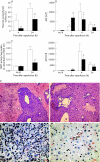Cholestasis protects the liver from ischaemic injury and post-ischaemic inflammation in the mouse
- PMID: 16763052
- PMCID: PMC1856663
- DOI: 10.1136/gut.2006.097170
Cholestasis protects the liver from ischaemic injury and post-ischaemic inflammation in the mouse
Abstract
Background and hypothesis: Cholestasis is associated with high morbidity and mortality in patients undergoing major liver surgery, but the mechanisms responsible remain elusive. Increased ischaemic liver injury and inflammation may contribute to the poor outcome.
Methods: Common bile duct ligation (biliary obstruction with hyperbilirubinaemia) or selective ligation of the left hepatic duct (biliary obstruction without hyperbilirubinaemia) was performed in C57BL/6 mice before 1 h of hepatic ischaemia and 1, 4 or 24 h of reperfusion. Infection with the intracellular hepatic pathogen Listeria monocytogenes for 12 and 48 h was used to study ischaemia-independent hepatic inflammation.
Results: Cholestatic mice showed considerable protection from ischaemic liver injury as determined by transaminase release, histological liver injury and neutrophil infiltration. In cholestatic mice, reduced injury correlated with a failure to activate nuclear factor kappaB (NFkappaB) and tumour necrosis factor alpha (TNFalpha) mRNA synthesis, two key mediators of post-ischaemic liver inflammation. After selective bile duct ligation, both the ligated and the non-ligated lobes showed blocked activation of NFkappaB as well as reduced induction of TNFalpha mRNA synthesis and neutrophil infiltration. By contrast, infection with L monocytogenes showed comparable activation of NFkappaB and hepatic recruitment of neutrophils 12 h after infection.
Conclusion: Cholestasis does not increase but rather dramatically protects the liver from ischaemic injury and inflammation. This effect is mediated by a systemic factor, but not bilirubin, and is associated with a preserved capacity to trigger an inflammatory response to other stimuli such as a bacterial pathogen.
Conflict of interest statement
Competing interests: None.
References
Publication types
MeSH terms
Substances
LinkOut - more resources
Full Text Sources
Other Literature Sources





